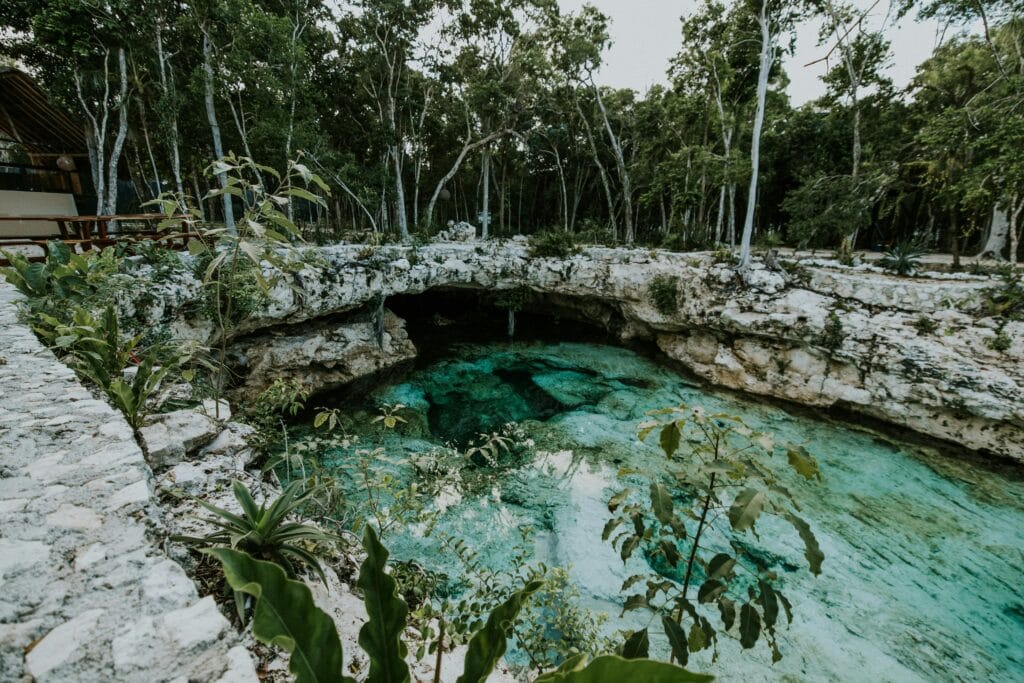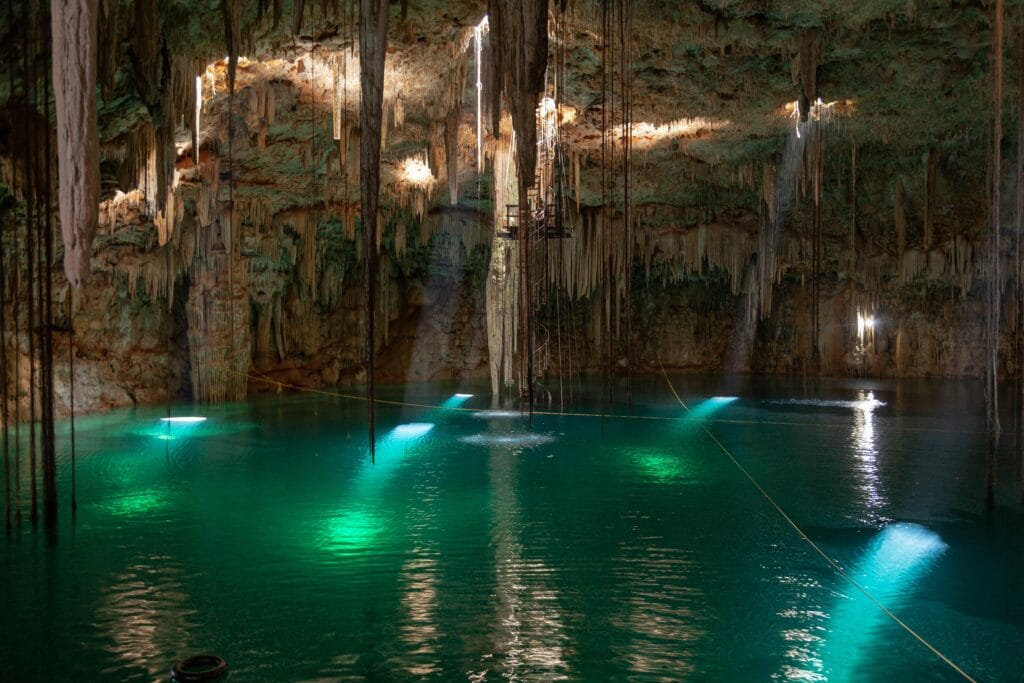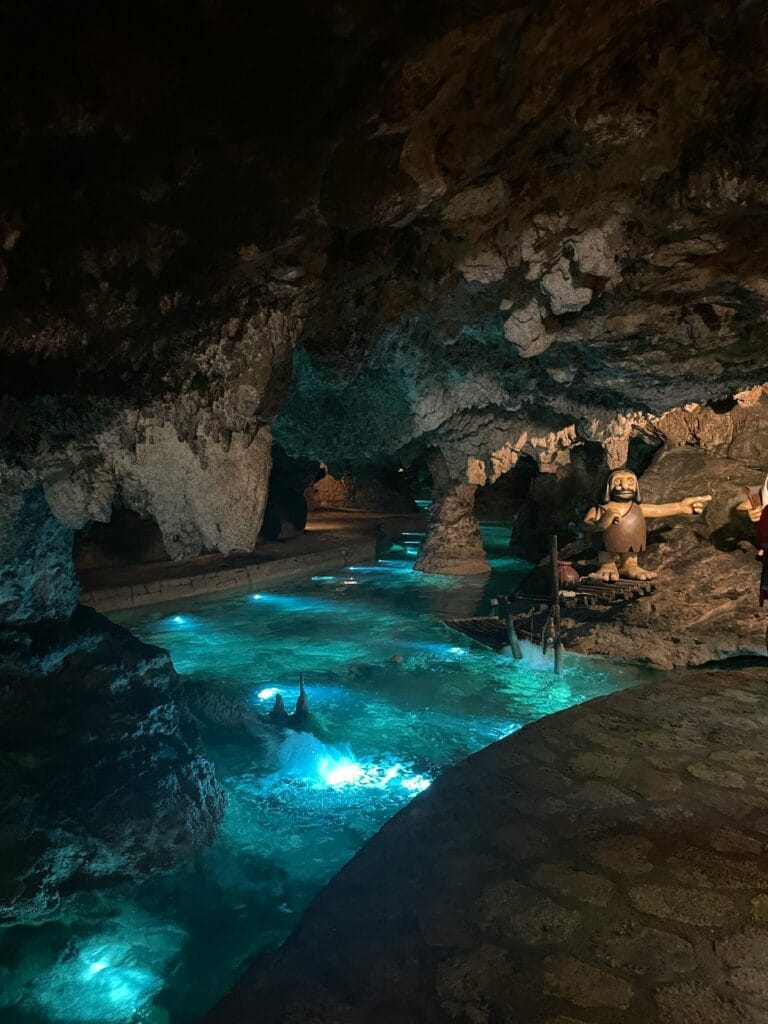Discover the most spectacular cenotes in Mexico’s Yucatán Peninsula, from hidden gems to accessible swimming spots, plus everything you need to know about visiting these sacred Maya portals responsibly.
Table of Contents
- What Are Cenotes? Understanding Sacred Waters
- Best Cenotes by Region
- Types of Cenotes: Which Style Suits You
- Essential Safety Guidelines
- What to Bring: Complete Packing List
- Best Times to Visit
- Cenote Etiquette: Respecting Sacred Spaces
- Plan Your Cenote Adventure
- Frequently Asked Questions
What Are Cenotes? Understanding Sacred Waters
Cenotes (pronounced “seh-NO-tay”) are natural sinkholes formed when limestone bedrock collapses, revealing the groundwater beneath. The Yucatán Peninsula contains over 6,000 known cenotes, created by the same geological processes that formed the world’s largest underwater cave system.
For the ancient Maya, cenotes weren’t just water sources—they were sacred portals to Xibalba, the underworld. Archaeological evidence shows that Maya communities conducted ceremonies at cenotes for over 1,000 years, leaving offerings of jade, gold, and even human sacrifices in their depths.
According to Dr. Guillermo de Anda, director of the Great Maya Aquifer Project, “Every cenote was considered sacred by the Maya. They believed these waters connected the terrestrial world with the spiritual realm below.”

The Science Behind the Sacred
The cenotes of the Yucatán exist because of a cosmic catastrophe. Sixty-six million years ago, an asteroid impact created the Chicxulub crater, weakening the limestone foundation. Over millennia, slightly acidic rainwater dissolved the stone, creating the underground river systems and cenotes we see today.
This geological history creates three distinct types of cenotes, each offering different experiences for visitors.
Best Cenotes by Region
Near Mérida (Western Yucatán)
Cenote Xlacah (Dzibilchaltún)
- Type: Open cenote
- Best for: History enthusiasts and families
- Special feature: Swimming next to ancient Maya ruins
- Facilities: Changing rooms, parking, guided tours available
- Entry fee: Included with Dzibilchaltún archaeological site admission ($80 MXN)
Located within the Dzibilchaltún archaeological site, this cenote offers the unique experience of swimming where Maya nobility once bathed. The clear, shallow waters make it ideal for non-expert swimmers.
Cenote San Ignacio
- Type: Semi-open with cave formations
- Best for: Photography and peaceful swimming
- Special feature: Stunning light beams at midday
- Facilities: Eco-friendly facilities, local guide service
- Entry fee: $150 MXN
Operated by a local cooperative, San Ignacio features dramatic stalactite formations and crystal-clear water. The cenote remains pleasantly cool even during hot afternoons.
Valladolid Region (Central Yucatán)
Cenote Suytun
- Type: Underground cave cenote
- Best for: Instagram photography and unique swimming
- Special feature: Dramatic platform surrounded by water
- Facilities: Restaurant, changing rooms, life jackets provided
- Entry fee: $100 MXN
Perhaps the most photographed cenote in the Yucatán, Suytun’s circular platform creates stunning photo opportunities when sunlight streams through the opening above.
Cenote Zaci (Downtown Valladolid)
- Type: Semi-open cenote
- Best for: Convenient city swimming
- Special feature: Accessible location in city center
- Facilities: Changing rooms, restaurant, parking
- Entry fee: $30 MXN
Located just blocks from Valladolid’s main plaza, Zaci offers easy access without sacrificing natural beauty. The cenote features a small waterfall and resident catfish that locals consider sacred.
Cenote Xkeken (Dzitnup)
- Type: Underground cave cenote
- Best for: Adventure and cave swimming
- Special feature: Dramatic stalactite formations
- Facilities: Shared with neighboring Cenote Samula
- Entry fee: $125 MXN (includes both Xkeken and Samula)
Also known as Dzitnup, this cenote requires descending stone steps into a cavern illuminated by a single opening. The water glows with an ethereal blue light.
Homun Region (Cenote Ring)
Cenote Kankirixche
- Type: Cathedral-style cave cenote
- Best for: Spiritual experiences and photography
- Special feature: Massive cavern with multiple water levels
- Facilities: Basic changing areas, local guides
- Entry fee: $80 MXN
Part of the Homun cenote ring, Kankirixche feels like swimming in an underground cathedral. The cenote features multiple levels connected by natural stone formations.
Cenote Santa Barbara
- Type: Four connected cenotes
- Best for: Full-day cenote hopping
- Special feature: Variety of swimming environments in one location
- Facilities: Restaurant, hammocks, full-service facilities
- Entry fee: $200 MXN (all four cenotes)
This complex offers four different cenote experiences, from open-air swimming to cave exploration, making it perfect for visitors who want variety.
Tulum Region (Caribbean Coast)
Gran Cenote
- Type: Semi-open with cave sections
- Best for: Snorkeling and turtle watching
- Special feature: Sea turtles and extensive underwater formations
- Facilities: Full facilities, snorkel gear rental
- Entry fee: $380 MXN
One of the most developed cenotes near Tulum, Gran Cenote offers excellent visibility for snorkeling and frequent turtle sightings in the cave sections.
Cenote Calavera (Temple of Doom)
- Type: Open cenote with cave entrance
- Best for: Cliff jumping and adventure
- Special feature: Three holes for different jumping heights
- Facilities: Basic facilities, bring your own gear
- Entry fee: $100 MXN
Popular with adventure seekers, Calavera offers cliff jumping opportunities and connects to an extensive underwater cave system for certified cave divers.
Types of Cenotes: Which Style Suits You
Open Cenotes (Aguadas)
Best for: Families, non-swimmers, hot weather relief Examples: Xlacah, Santa Barbara exterior
Open cenotes resemble natural pools with direct sunlight and often feature shallow areas perfect for children. These typically have the warmest water and easiest access.

Semi-Open Cenotes
Best for: Photography, moderate adventure, varied experiences Examples: Zaci, Gran Cenote
Partially covered by rock formations, these cenotes offer dramatic lighting effects as sunbeams penetrate openings in the stone ceiling. They provide adventure without claustrophobia.

Underground Cave Cenotes
Best for: Adventure seekers, unique experiences, cooler temperatures Examples: Suytun, Xkeken, Kankirixche
Completely enclosed by rock formations, cave cenotes offer the most dramatic environments but require comfort in enclosed spaces. Water temperatures remain constant year-round.

Essential Safety Guidelines
Before You Enter
- Check your swimming ability: Many cenotes have deep sections with no shallow areas
- Inform someone of your plans: Cell service is often limited in cenote areas
- Bring a waterproof flashlight: Useful for cave cenotes and underwater exploration
- Consider your comfort level: If you’re claustrophobic, stick to open or semi-open cenotes
Water Safety
- Never dive headfirst: Water depth can vary dramatically, and rocks may be hidden
- Stay within your limits: Strong swimmers should still exercise caution in cave systems
- Use provided life jackets: Many cenotes require them, especially for non-swimmers
- Watch for wildlife: While rare, crocodiles have been spotted in some coastal cenotes
Health Considerations
According to local health authorities, cenote water is generally safe for swimming, but:
- Research whether the water has been tested for E. coli
- Avoid swallowing water: As with any natural water source
- Check for cuts or open wounds: Bacteria can enter through broken skin
- Shower after swimming: Especially important in cave cenotes
What to Bring: Complete Packing List
Essential Items
- Biodegradable sunscreen: Regular sunscreen damages cenote ecosystems
- Water shoes: Rocky entries can be sharp and slippery
- Quick-dry towel: Regular towels stay damp in humid conditions
- Dry bag: To protect electronics and valuables
- Snorkel gear: If you plan to explore underwater (check cenote rules first)
Recommended Additions
- Waterproof flashlight: Essential for cave cenotes
- Waterproof camera or phone case: For underwater photography
- Change of clothes: In waterproof bag
- Cash in small bills: Many cenotes only accept cash
- Insect repellent: For jungle cenotes (apply before arrival, not at cenote)
- First aid basics: Band-aids and antiseptic
What NOT to Bring
- Regular sunscreen or lotions: Damages water quality
- Food or drinks: Most cenotes prohibit outside food
- Soap or shampoo: Even biodegradable versions can harm ecosystems
- Alcohol: Prohibited at all cenotes
Best Times to Visit
By Season
Dry Season (November-April)
- Pros: Clear skies, cooler temperatures, better road conditions
- Cons: Higher prices, more crowds, cooler water temperatures
- Best for: First-time visitors, photography, comfortable swimming
Rainy Season (May-October)
- Pros: Fewer crowds, lower prices, lush jungle scenery
- Cons: Afternoon storms, higher humidity, muddy roads to remote cenotes
- Best for: Budget travelers, avoiding crowds, experiencing tropical landscapes
By Time of Day
Early Morning (8-10 AM)
- Fewer crowds, better light for photography, cooler temperatures
- Many cenotes open at 8 AM
Midday (11 AM-2 PM)
- Dramatic light beams in cave cenotes
- Warmest water temperatures
- Peak crowd times at popular cenotes
Late Afternoon (3-5 PM)
- Avoiding midday heat, fewer tour groups
- Some cenotes close early, so confirm hours
Cenote Etiquette: Respecting Sacred Spaces
Environmental Protection
- Shower before entering: Removes lotions and oils that harm water quality
- Don’t touch formations: Stalactites and stalagmites are fragile and take millennia to form
- Stay on marked paths: Prevents erosion and protects fragile ecosystems
- Pack out all trash: Leave no trace principles apply
Cultural Sensitivity
- Lower your voice: Cenotes are sacred spaces deserving reverence
- Don’t climb on altars or offerings: Respect contemporary spiritual practices
- Ask permission for photos: Especially of local families or spiritual ceremonies
- Tip local guides appropriately: Standard rate is 10-15% of tour cost
Supporting Local Communities
Many of the best cenote experiences come from community-operated sites where entry fees directly support local families. These cooperatives often provide:
- More authentic experiences
- Local guides with cultural knowledge
- Better environmental protection
- Economic benefits to Maya communities
Planning Your Cenote Adventure
Transportation Options
Rental Car
- Pros: Flexibility to visit multiple cenotes, access to remote locations
- Cons: Navigation challenges, parking concerns at popular sites
- Best for: Independent travelers, cenote hopping
Organized Tours
- Pros: Transportation included, expert guides, no navigation stress
- Cons: Limited time at each location, larger groups
- Best for: First-time visitors, those without rental cars
Local Colectivos and Buses
- Pros: Budget-friendly, authentic experience
- Cons: Limited schedules, may require walking to cenotes
- Best for: Budget travelers, Spanish speakers
Recommended Cenote Combinations
Half-Day Trip from Valladolid Cenote Zaci (city center) → Cenote Suytun (photography) → Cenote Xkeken (cave experience)
Full-Day Homun Adventure Santa Barbara complex (four cenotes) → Kankirixche (cathedral experience) → local restaurant lunch
Tulum Cenote Circuit Gran Cenote (morning, fewer crowds) → Cenote Calavera (adventure activities) → Cenote Carwash (afternoon relaxation)
Connecting with Sacred Waters
Swimming in a cenote offers more than just relief from the Yucatán heat—it’s an opportunity to connect with thousands of years of Maya spiritual tradition while experiencing some of Mexico’s most spectacular natural wonders.
Whether you choose the accessible beauty of Cenote Xlacah near Mérida or venture into the cathedral-like chambers of Kankirixche in the Homun region, each cenote offers a unique window into the geological and cultural forces that have shaped the Yucatán Peninsula.
Remember that these aren’t just swimming holes—they’re sacred spaces that deserve our respect and protection. By visiting responsibly and supporting community-operated cenotes, you’re helping ensure that future generations can experience the magic of swimming in sacred Maya waters.
Ready to explore more of the authentic Yucatán Peninsula? Discover our complete guide to Beyond Cancún: The Authentic Yucatán Peninsula for more hidden gems and cultural experiences that go far beyond the resort zone.
Planning your cenote adventure? Download our free “Cenote Planning Checklist” with maps, entry fees, and insider tips for 15 must-visit cenotes across the Yucatán Peninsula.
Frequently Asked Questions
Q: Can non-swimmers enjoy cenotes? A: Absolutely! Many cenotes have shallow areas and provide life jackets. Open cenotes like Xlacah are particularly good for non-swimmers.
Q: Is it safe to swim in cenotes? A: Yes, when you follow safety guidelines. The water is generally clean, but avoid swallowing it and shower afterward.
Q: Do I need to book cenote visits in advance? A: Popular cenotes like Suytun may require reservations during peak season. Community-operated cenotes usually accept walk-ins.
Q: Can I bring my own snorkel gear? A: Most cenotes allow personal snorkel gear, but some have restrictions. Check individual cenote policies.
Q: What’s the water temperature in cenotes? A: Cenote water maintains a constant temperature of around 75-78°F (24-26°C) year-round.
Q: Are there crocodiles in cenotes? A: Very rarely, and only in coastal cenotes that connect to the ocean. Inland freshwater cenotes don’t have crocodiles.


